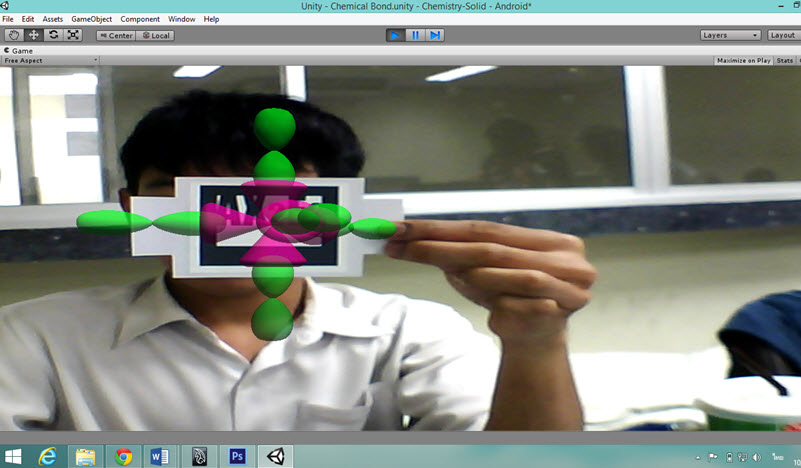การพัฒนาสื่อการเรียนรู้เรื่อง โครงสร้างอะตอมและพันธะเคมี ด้วยเทคโนโลยีออกเมนเต็ดเรียลลิตี้
Main Article Content
Abstract
Nadh Ditcharoen, Korawat Polyiam, Panida Vangkahad and Purim Jarujamrus
รับบทความ: 26 เมษายน 2557; ยอมรับตีพิมพ์: 28 พฤษภาคม 2557
บทคัดย่อ
งานวิจัยนี้มีวัตถุประสงค์เพื่อพัฒนาสื่อการเรียนรู้รายวิชาเคมี เรื่องโครงสร้างอะตอม และพันธะเคมีโดยการประยุกต์ใช้เทคโนโลยีออกเมนเต็ดเรียลลิตี้ (Augmented Reality) ซึ่งเป็นการจำลองโมเดลลักษณะโครงสร้างของอะตอมและพันธะเคมีในรูปแบบแอนิเมชั่นสามมิติ จำนวน 34 โมเดลที่สามารถใช้งานได้ทั้งเครื่องคอมพิวเตอร์และแท็บเล็ตที่ใช้ระบบปฏิบัติการแอนดรอยด์ สื่อการเรียนรู้นี้พัฒนาด้วยโปรแกรม Autodesk Maya โปรแกรม Photoshop และโปรแกรม Unity 3D ผลการพัฒนาและทดสอบระบบด้วยการวิเคราะห์ความสอดคล้องของเนื้อหา (ค่า IOC) และศึกษาความพึงพอใจด้วยแบบสอบถามจากผู้เชี่ยวชาญจำนวน 5 คน และนักศึกษาจำนวน 60 คน ของมหาวิทยาลัยอุบลราชธานี พบว่า ความสอดคล้องของเนื้อหามีค่าเฉลี่ยเท่ากับ 0.81 และค่าเฉลี่ยของความพึงพอใจ มีค่าเท่ากับ 4.36 (จากคะแนนเต็ม 5.00) ซึ่งสามารถสรุปได้ว่า คุณภาพโดยรวมของสื่อการเรียนรู้นี้อยู่ในระดับดี ช่วยเพิ่มความเข้าใจในเนื้อหารายวิชาเคมีได้อย่างถูกต้องและรวดเร็วกว่าการเรียนด้วยบทเรียนแบบเดิมที่เป็นภาพแบบสองมิติ
คำสำคัญ: ออกเมนเต็ดเรียลลิตี้ โครงสร้างอะตอม พันธะเคมี แอนดรอยด์ สื่อการเรียนรู้
Abstract
The objective of this research was to develop a media for learning chemistry in the topics of Atomic Structure and Chemical Bond using Augmented Reality (AR) technology. The 34 models of chemical structures were simulated in form of 3D animations which were able to run on both personal computers and android tablets. This media was developed by using Autodesk Maya, Photoshop, and Unity 3D. The performance of the learning media was studied by analyzing the item-objective congruence (IOC) and users’ satisfaction using a questionnaire collected from 5 experts and 60 students of Ubon Ratchathani University. The findings indicated that the index of IOC was 0.81, and the average of students’ satisfaction was 4.36 (in toto 5.00). It can be concluded that the overall performance of developed media is high level. The learning media could help students gain a better understanding of chemistry comparing with the traditional method.
Keywords: Augmented reality, Atomic structure, Chemical bond, Android, Learning media
Downloads
Article Details

This work is licensed under a Creative Commons Attribution-NonCommercial 4.0 International License.
References
นริศรา กาฬมาตย์ และชนาธรณ์ ธูปพุดซา. (2554). การประยุกต์ใช้เทคโนโลยีออกเมนเต็ดเรียลลิตี้ สำหรับหนังสือการ์ตูน 3 มิติ เรื่อง พระมหาชนก. สารนิพนธ์วิทยาศาสตรบัณฑิต สาขาวิชาเทคโนโลยีสารสนเทศ ภาควิชาคณิตศาสตร์ สถิติ และคอมพิวเตอร์ คณะวิทยาศาสตร์ มหาวิทยาลัยอุบลราชธานี.
พนิดา ตันศิริ. (2553). โลกเสมือนผสานโลกจริง (Augmented reality). วารสารนักบริหาร มหาวิทยาลัยกรุงเทพ 30(2): 169-175.
มนต์ชัย เทียนทอง. (2548). สถิติและวิธีการวิจัยทางเทคโนโลยีสารสนเทศ. กรุงเทพฯ: สถาบันเทคโนโลยีพระ-จอมเกล้าพระนครเหนือ.
วสันต์ เกียรติแสงทอง พรรษพล พรหมมาศ และอนุวัตร เฉลิมสกุลกิจ. (2552). การศึกษาเทคโนโลยีออคเมนต์เตด เรียลลิตี้: กรณีศึกษาพัฒนาเกมส์ “เมมการ์ด”. โครงงาน สาขาวิทยาการคอมพิวเตอร์ มหาวิทยาลัย ศรีนครินทรวิโรฒ. http://facstaff.swu.ac.th/praditm/CP499_2552_AR.pdf สืบค้นเมื่อวันที่ 10 กุมภาพันธ์ 2557.
วิวัฒน์ มีสุวรรณ์. (2554). การเรียนรู้ด้วยการสร้างโลกเสมือนผสานโลกจริง. วารสารศึกษาศาสตร์ มหาวิทยาลัยนเรศวร 13(2): 119-127.
Izzurrachman, F. (2012). Particle effect on augmented reality for chemical bond learning. Department of Electrical Engineering, Faculty of Industrial Engi-neering, Sepuluh Nopember Institute of Technology. เข้าถึงได้จาก http://digilib.its.ac.th สืบค้นเมื่อวันที่ 10 กุมภาพันธ์ 2557.
Kaufmann, H. (2003). Collaborative Augmented Reality in Education. Institute of Software Techno-logy and Interactive Systems, Vienna University of Technology, Keynote Speech at Imagina Conference. เข้าถึงได้จาก http://www.ita.mx/files/ avisos-desplegados/ingles-tecnico/guias-estudio-abril-2012/articulo-informatica-1.pdf ที่สืบค้นเมื่อวันที่ 10 กุมภาพันธ์ 2557.
